Rickets is caused due to Vitamin ‘D’ deficiency
Rickets is caused due to Vitamin ‘D’ deficiency or improper metabolism of vitamin D, calcium or phosphate. Rickets leads to softening and weakening of bones etc. It is quite common problem in children in underdeveloped and developing countries. It occurs due to lack of proper nutrition or starvation. It occurs in adults too.
The primary cause of rickets is a vitamin D deficiency. Vitamin D is needed for the metabolism of calcium and phosphorus in the body, which, in turn affects how calcium is deposited in the bones, thus it is considered essential for proper bone development and growth. Sunlight, especially ultraviolet light, lets human skin cells convert vitamin D from an inactive to active state. In the absence of vitamin D, dietary calcium is not properly absorbed, resulting in hypocalcaemia, leading to skeletal and dental deformities and neuromuscular symptoms.
Foods that contain vitamin D include butter, eggs, fish liver oils, margarine, fortified milk and juice, portabella and shiitake mushrooms, and oily fishes such as tuna, herring, and salmon.
A rare X-linked dominant form exists called vitamin D-resistant rickets or X-linked hypophosphatemia.
- Pain or tenderness in the bones of your arms, legs, pelvis, or spine
- Deformities in your teeth or delayed tooth formation, an increased number of cavities, holes in your enamel, abscesses, or defects in the structure of your teeth

- Impaired growth and short stature
- Bone fractures
- Muscle cramps
- Skeletal deformities, including: an oddly shaped skull, legs that bow out (bowlegs), bumps in your ribcage, a protruding breastbone, a curved spine pelvic deformities
Diagnosis
Rickets may be diagnosed with the help of:
Blood tests: Serum calcium may show low levels of calcium, serum phosphorus may be low, and serum alkaline phosphatase may be high from bones or changes in the shape or structure of the bones. This can show enlarged limbs and joints.
Bone biopsy is rarely performed but will confirm rickets.
Treatment and prevention
The most common treatment of rickets is intake of Vitamin D rich food sources or tablets. However, surgery may be required to remove severe bone abnormalities.
Increased dietary intake of calcium, phosphates and vitamin D is essential, cod liver oil, halibut liver oil, viosterol, milk, eggs are all good sources of vitamin D.
A sufficient amount of ultraviolet B light in sunlight each day and adequate supplies of calcium and phosphorus in the diet can prevent rickets. Darker-skinned people need to be exposed longer to the ultraviolet rays. Most dermatologists recommend vitamin D supplementation as an alternative to unprotected ultraviolet exposure due to the increased risk of skin cancer associated with sun exposure.

